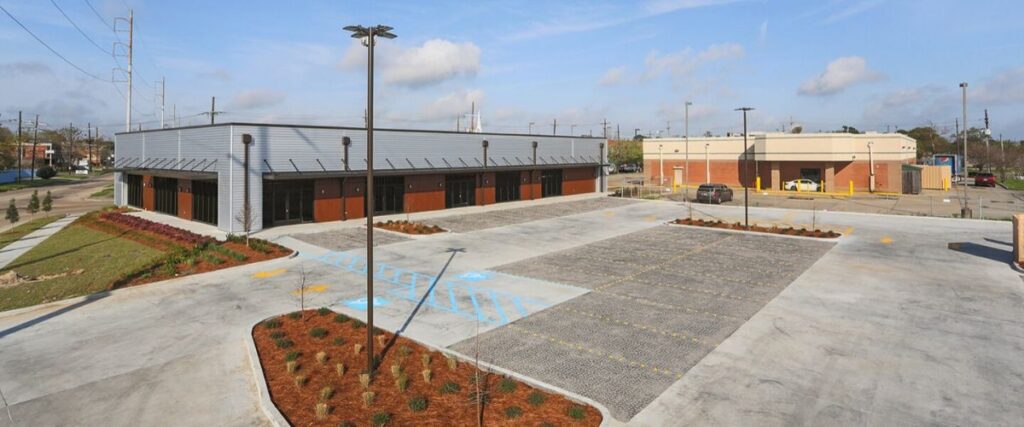
Commercial green construction has come a long way since the first builder lined up a solar array on a warehouse roof. At Perrier Esquerré Contractors, we are constantly analyzing and implementing the newest green construction techniques for our Louisiana commercial builds. Whether you are looking to retrofit an existing structure or want to design a new build from the ground up, here are the biggest trends in commercial green construction to watch.
What is commercial green construction?
Green construction uses specific design, building, or operational techniques to help reduce a building’s impact on the environment. Some of the ways that green buildings do this is by:
- Efficiently using energy and water
- Utilizing renewable energy (e.g., solar or wind energy)
- Reducing pollution and waste
- Enabling re-use and recycling of waste materials
- Providing high-quality indoor air
- Using non-toxic, ethically made, and sustainable materials
- Taking the environment into consideration in all aspects of design, construction, and operation
- Thinking about how occupants will actually use the building to improve quality of life
- Creating an adaptable design for a changing environment
Green commercial construction has exploded in the past decade. In fact, LEED-certified projects in the U.S. rose from 296 in 2006 to more than 67,200 in 2018. In 2020, these are the biggest trends shaping the industry.
1. Net zero energy buildings
The goal in green building construction has always been to reduce the amount of resources a building uses. With a net zero building, the building makes enough of its own energy that it needs zero nonrenewable energy from outside the building.
There are a wide variety of net zero energy buildings already in operation, from a Walgreens in Evanston, Illinois to a federal building in Colorado. These buildings utilize a variety of the strategies to protect the environment and enrich the lives of the buildings’ users.
2. Biomimicry
Biomimicry is a way of designing a building so that it works seamlessly with the natural environment, not against it. Design and construction techniques are inspired by natural designs.
For example, some buildings use wastewater treatment in a way that mimics wetlands. Others use tree-like structures to provide stronger, more durable, and beautiful roof supports. In addition, builders also use natural materials to reduce a building’s environmental footprint like timbercrete, a more sustainable concrete option, or sheep’s wool for insulation. And finally, some buildings bring nature into the design itself with living walls and green roofs.
3. Modern water conservation techniques
Now more than ever, green construction has seen a surge in demand for buildings that not only conserve the use of water via low-flow toilets, sinks, and showerheads but that also re-use grey water.
Dual plumbing uses recycled grey water to flush toilets and irrigate landscaping. This water is what remains after hand washing or doing dishes and can be reused with less treatment.
In addition to recycling grey water, many green construction projects harvest rainwater on a larger scale, also for landscape irrigation and other non-drinking uses. This is an excellent way to offset all of the impervious surfaces that can be created during commercial construction, too.
4. Smart buildings and distributed energy systems (DES)
Smart buildings (also referred to as “intelligent” buildings) use automated processes to place a check on waste. These processes include things like turning lights off and on, controlling the building temperature, and otherwise controlling the physical building.
When coupled with distributed energy systems (DES) that are efficient and utilize renewable sources of energy, this category of green construction alone can help preserve and protect that environment.
Green construction examples in this category are located across the globe, demonstrating that they are a viable green building option in any climate.
5. Climate change resistant buildings
And speaking of climate, one of the major trends in green construction is climate-change resistant buildings. As extreme weather events become more common and frequent, green architecture is adapting to these changes.
Climate change resistant buildings are less reliant on outside resources and actually work to protect the building with materials that resist weather extremes. For example, in Taiwan, Taipei 101 houses a ball inside of the structure that helps it resist typhoons. The Italy Pavilion in Milan is made from materials that absorb air pollution and smog. These are just a few examples of green construction projects that actually makes the world around it better.
6. Calculating (and offsetting) carbon footprint
Calculating the carbon footprint is perhaps the first step to take when planning any project. A carbon footprint is the amount of carbon emitted by a building, a group, or a person. Calculating a building’s carbon footprint at every step of construction can help decide which green construction changes will be most efficient, effective, and affordable.
This can be especially helpful when working within a budget and planning changes to offset your company’s carbon footprint.
Work with Perrier Esquerré Contractors
Perrier Esquerré Contractors are Louisiana LEED Green Associates who can help you navigate the latest changes in commercial green construction. We offer Design-Build, New Construction, Interior Build-Outs, Renovations, and Construction Management services. Our team believes in designing collaborative, innovative green projects and ground our work in honesty, integrity, and the highest professional standards. Whether you are exploring green construction from the ground up or want to renovate your existing buildings, Perrier Esquerré can help. Get in touch today.